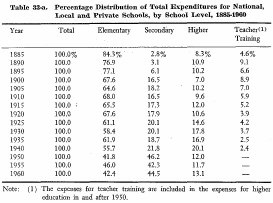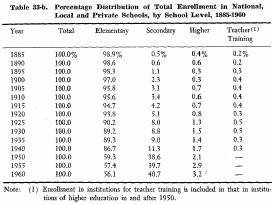| Home > Policy > White Paper, Notice, Announcement > White Paper > JAPAN'S GROWTH AND EDUCATION 1963 > CHAPTER |
||
The percentage distribution of total school expenditures and enrollments in Japan, by level of education, during tlae period 1885-1960 is shown in Table 33.


The table shows that the percentage of total educational expenses devoted to elementary education has gradually decreased since 1885 while the percentages for secondary and higher education have increased. The early period of expansion of secondary education, including the normal schools which were of secondary level, is shown in the marked increase in percentage of educational costs devoted to these schools from 1890 to 1905. Even sharper increases resulted from the inclusion of grades 7-9 in compulsory education, and the appropriations of large sums for construction of new lower secondary schools after the war. The same factors caused the proportionate increases in post-war percentages of total school population enrolled in secondary schools.
The percentage of total educational expenditures allotted to
higher education remained almost static until 1925. Subsequent increases continued
until the period of World War ![]() .
Decreases following the war resulted from excessive costs for reconstruction
and rehabilitation of elementary and secondary schools damaged or destroyed during
the war, and the expenditure of large amounts for construction of new lower secondary
schools to meet the requirements of educational reorganization and extension
of compulsory education.
.
Decreases following the war resulted from excessive costs for reconstruction
and rehabilitation of elementary and secondary schools damaged or destroyed during
the war, and the expenditure of large amounts for construction of new lower secondary
schools to meet the requirements of educational reorganization and extension
of compulsory education.
The percentage of total school population enrolled in elementary schools decreased slowly from nearly 99 per cent in 1885 to 86.7 per cent in 1940, while the percentages in secondary schools(including normal schools) and higher schools gradually increased from 0.7 per cent and 0.4 per cent, to 24.2 per cent and 20.1 per cent, respectively. After the war, the previous trends in elementary and secondary schools was sharply reversed by reclassification of grades 7-9 as secondary grades, while the trend in higher schools continued despite a marked reduction in the percentage of total school costs devoted to higher education. Tlae future task for which more effectiv measures should be taken will, therefore, be to increase the allotment of educational expenses to higher education for the purpose of the qualitative development of the education.
The percentage of total educational expenses devoted to teacher training declined almost continuously from 1890 to 1940. This is due to the fact that a greater effort was made in the period before 1910 for the establishment and expansion of institutions for teacher training. Percentages of total school population enrolled in such schools varied only between 0.3 percent and 0.5 per cent during the entire period from 1895 until they were discontinued after the war.
| Back to Top | MEXT HOME |